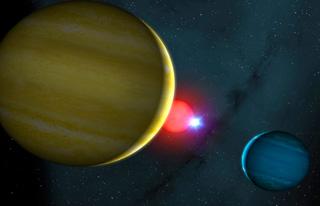
NN Serpentis - Snooker Star System. Photo by: The University of Warwick/Mark A. Garlick.
UNITED KINGDOM (BNS): Astronomers have recently unraveled an unusual star system which looks like a game of snooker.
The University of Warwick and Sheffield astronomers played a key role in an international team that used two decades of observations from many telescopes around the world.
The UK astronomers helped discover this “snooker like" star system through observations and analysis of data from an astronomical camera known as ULTRACAM designed by the British researchers on the team.
They looked at a binary star system called NN Serpentis which is 1,670 light years away from Earth.
NN Serpentis is actually a binary star system consisting of two stars, a red dwarf and a white dwarf, which orbit each other in an incredibly close, tight orbit.
Earth sits in the same plane as this binary star system, so astronomers can see the larger red dwarf eclipse the white dwarf every three hours and seven minutes.
The astronomers were able to use these incredibly frequent eclipses to spot a pattern of small but significant irregularities in the orbit of stars and were able to help demonstrate that that pattern must be due to the presence and gravitational influence of two massive gas giant planets. The more massive gas giant is about 6 times the mass of Jupiter and orbits the binary star every 15.5 years, the other orbits every 7.75 years and is about 1.6 times the mass of Jupiter.
"The two gas giants have different masses but they may actually be roughly the same size as each other, and in fact will also be roughly the same size as the red dwarf star they orbit. If they follow the patterns we see in our own star system of gas giants with a dominant yellow or blue colours, then it’s hard to escape the image of this system as being like a giant snooker frame with a red ball, two coloured balls, and dwarf white cue ball," Professor Tom Marsh from the University of Warwick’s Department of Physics, was quoted as saying in the University news release.
This star system will also have seen dramatic changes in what is a relatively recent time in astronomical terms what is now the White Dwarf “cue ball” of the system may have suffered, and caused, violent changes to its own orbit and the orbit of all the planets and stars in the system, the news report said.
"If these planets were born along with their parent stars they would have had to survive a dramatic event a million years ago: when the original primary star bloated itself into a red giant, causing the secondary star to plunge down into the present very tight orbit, thereby casting off most of the original mass of the primary. Planetary orbits would have seen vast disturbances," said Professor Vik Dhillon from the University of Sheffield.
"Alternatively, the planets may have formed very recently from the cast off material. Either way, in relatively recent times in astronomical terms this system will have seen a vast shock to the orbits of the stars and planets, all initiated by what is now the white dwarf at the heart of the system,'' he added.
The full research paper is published in the journal Astronomy and Astrophysics.
 Next Article
Next Article












The Indian Air Force, in its flight trials evaluation report submitted before the Defence Ministry l..
view articleAn insight into the Medium Multi-Role Combat Aircraft competition...
view articleSky enthusiasts can now spot the International Space Station (ISS) commanded by Indian-American astr..
view article